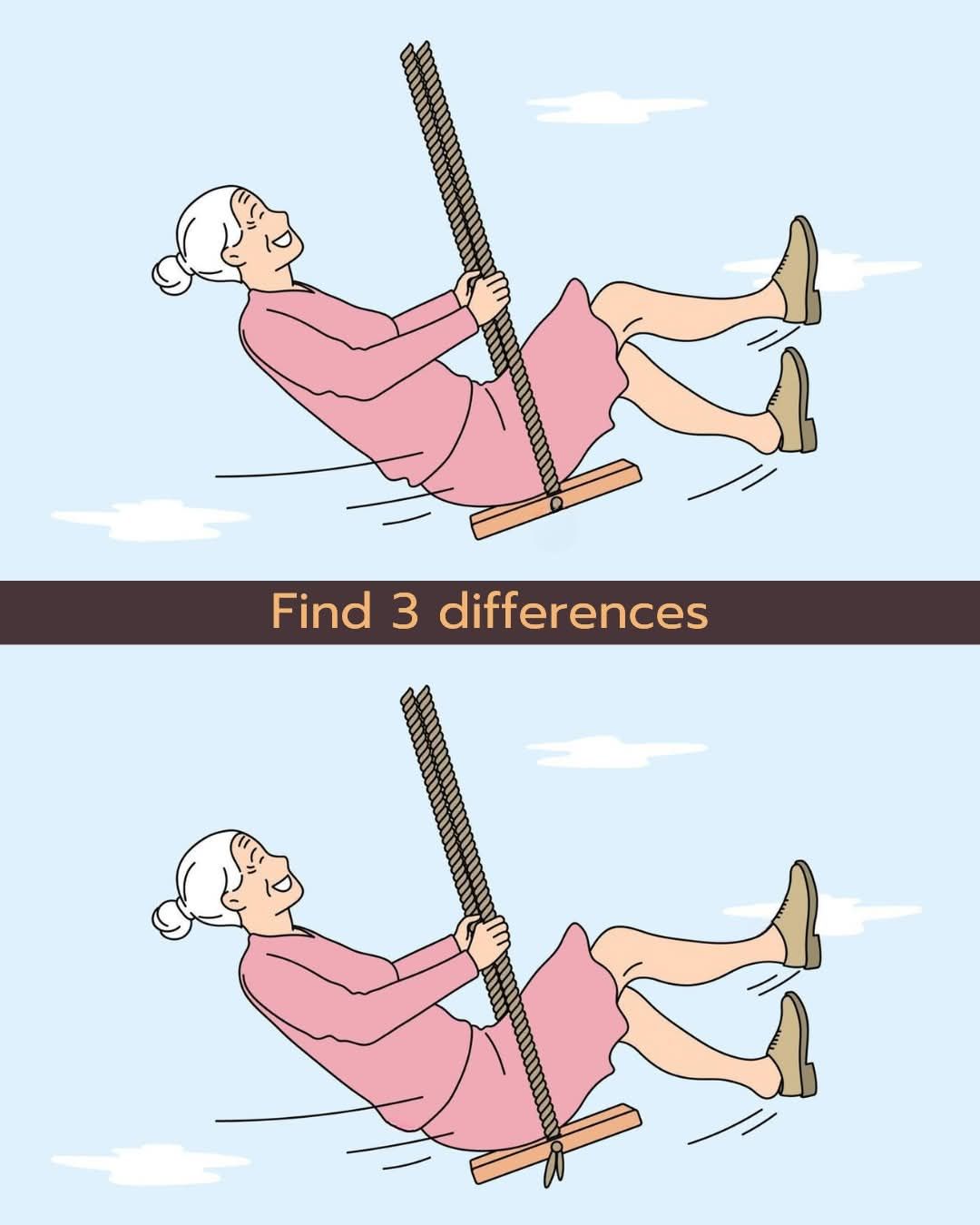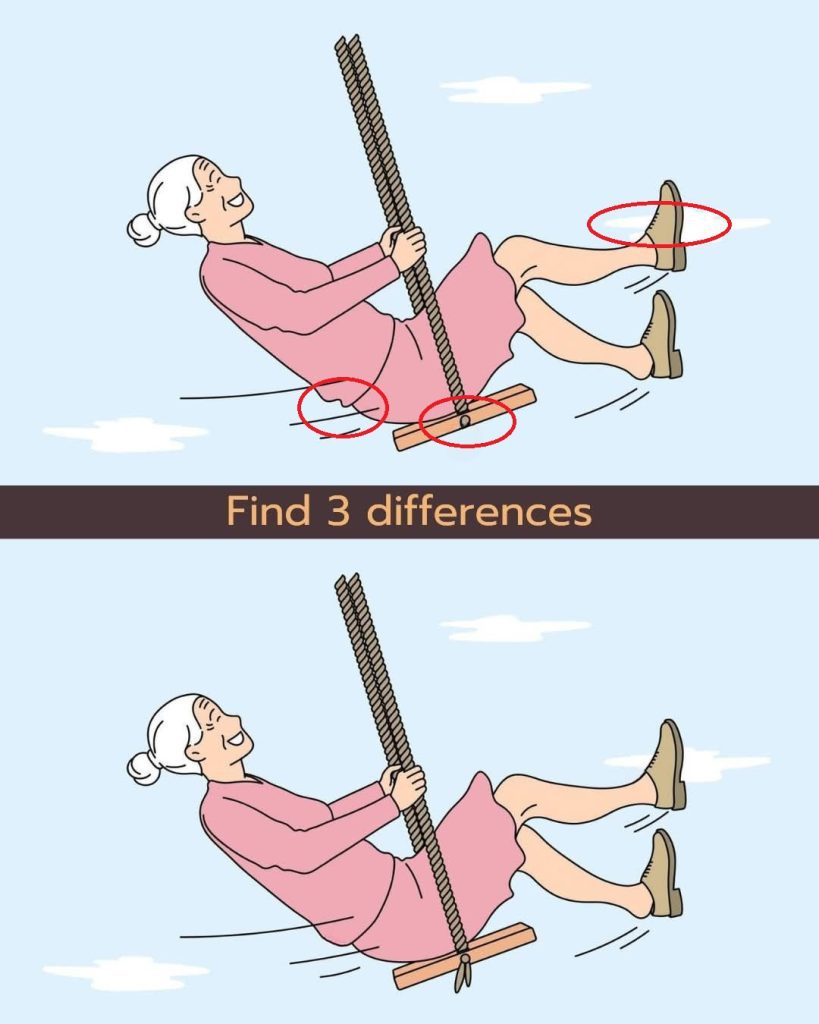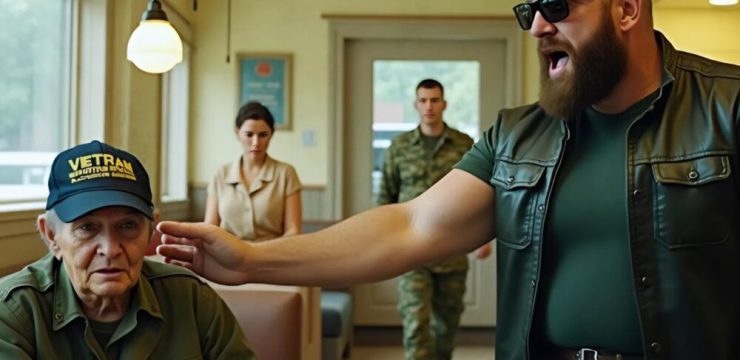In today’s digital age, where quick scrolling and instant gratification dominate how we consume content, the art of slowing down and really paying attention has almost become a lost skill. That’s what makes classic visual puzzles like “Spot the Difference” so powerful—they aren’t just playful distractions; they’re subtle, effective tools for exercising the mind.

The “Swinging Grandma” puzzle is a perfect example. At first glance, you might see two cheerful, identical illustrations of a grandma enjoying her time on a swing. But hidden within the joy and nostalgia are three small differences that test your observation skills and your patience. This seemingly simple image challenges how well you actually see what’s in front of you. At first, your brain wants to tell you that both images are exactly the same. That’s a natural reaction. Human brains are wired to seek patterns and simplify what we observe, especially when two visuals look almost identical. Our minds tend to gloss over the finer details, assuming similarity means sameness. But this assumption is exactly what this puzzle is designed to break.
By training yourself to go beyond a casual glance, to divide an image into smaller parts and assess each one closely, you begin to realize just how much you might normally miss. Experienced solvers of these types of puzzles don’t rely on luck or frantic eye movements. They use a systematic approach, dividing the scene into clear zones—the subject (in this case, grandma and her swing), the background (clouds, sky, open space), and the smaller dynamic elements (folds in clothing, accessories, posture, and ropes). This structure helps in spotting changes that otherwise blend in. So let’s take a closer look at the three hidden differences. First is the most central one: the missing bolt in the swing. In the top image, you’ll see a small black bolt right in the middle of the swing, where the two ropes connect to the wooden seat. It’s subtle, but it adds visual structure and believability to the swing.
However, in the bottom image, that bolt is completely missing—even though the ropes still appear attached. It’s a tiny alteration, but it shows how even in the focal point of an image, we can easily overlook what seems unimportant. This teaches us a valuable lesson: being in the center of attention doesn’t guarantee visibility if we take things for granted. The second change involves the cloud behind the grandma’s lifted right foot. Both images include a cloud in that area, so your mind might register it as “the same cloud,” but a closer inspection shows otherwise. In the top version, the cloud is compact and rounded, like a soft cotton puff. But in the bottom image, the same cloud is longer, more stretched out—almost like a smudge. This difference challenges your expectations, proving that presence isn’t everything; form matters just as much. Your brain might say, “Yes, the cloud is still there,” but the subtle change in its shape tells a different story. It’s an excellent example of how tiny differences in form can create a whole new perception.
Lastly, there’s a small change in grandma’s dress. In the top image, near her left hip (on the viewer’s right), there’s a gentle fold in the fabric. It gives the drawing life, indicating movement as she swings through the air. But that same fold is missing in the bottom image. The dress appears more flat, less alive. This difference is not about an object being there or not—it’s about energy. A simple crease suggests motion, and its removal changes the entire tone of the scene. It turns a lively image into a more static one, all through one subtle edit. So, why do these small differences matter? Because they train the brain in ways that go far beyond the image itself. Spot-the-difference puzzles help develop visual memory, strengthen pattern recognition, improve spatial awareness, and cultivate patience and deep focus.

They teach you to look again, to question your assumptions, and to be mindful of small details—skills that apply to everything from editing a document to reading someone’s facial expression. These are the very details that, when missed, can lead to costly errors or missed opportunities. In the case of this swinging grandma, the puzzle becomes more than just a game. It becomes a mindfulness tool, a lesson in observation, and a challenge that reminds us that even in our most familiar spaces, there are things waiting to be noticed. It asks us to slow down in a world that rushes us, to examine what we think we already know, and to find wonder in the tiniest of differences. So the next time someone tells you to “look closer,” take it seriously—you might be surprised at what you’ve missed.





